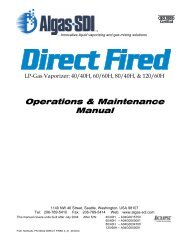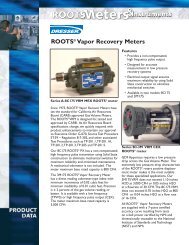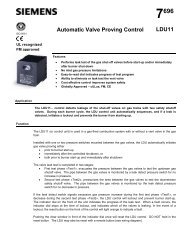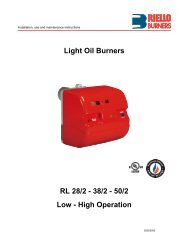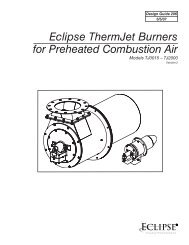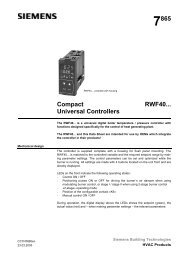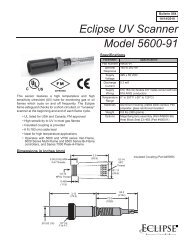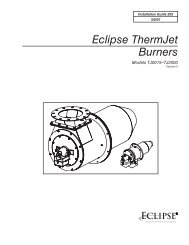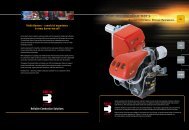Gas Burners RS 70/M - Power Equipment Company
Gas Burners RS 70/M - Power Equipment Company
Gas Burners RS 70/M - Power Equipment Company
You also want an ePaper? Increase the reach of your titles
YUMPU automatically turns print PDFs into web optimized ePapers that Google loves.
APPENDIX - Burner firing rates according to air density<br />
above sea level<br />
average barom.<br />
pressure<br />
CORRECTION FACTOR F<br />
Air temperature<br />
°F (°C)<br />
ft m “ W.C. mbar 0 (0°C) 41 (5°C) 50 (10°C) 59 (15°C) 68 (20°C) 77 (25°C) 86 (30°C) 104 (40°F)<br />
0<br />
329<br />
658<br />
987<br />
1316<br />
1645<br />
1974<br />
2303<br />
2632<br />
2961<br />
3290<br />
3947<br />
4605<br />
5263<br />
5921<br />
6579<br />
0<br />
100<br />
200<br />
300<br />
400<br />
500<br />
600<br />
<strong>70</strong>0<br />
800<br />
900<br />
1000<br />
1200<br />
1400<br />
1600<br />
1800<br />
2000<br />
399<br />
394<br />
389<br />
385<br />
380<br />
376<br />
372<br />
367<br />
363<br />
358<br />
354<br />
346<br />
337<br />
329<br />
321<br />
313<br />
1013<br />
1000<br />
989<br />
978<br />
966<br />
955<br />
944<br />
932<br />
921<br />
910<br />
898<br />
878<br />
856<br />
836<br />
815<br />
794<br />
1,087<br />
1,073<br />
1,061<br />
1,050<br />
1,037<br />
1,025<br />
1,013<br />
1,000<br />
0,988<br />
0,977<br />
0,964<br />
0,942<br />
0,919<br />
0,897<br />
0,875<br />
0,852<br />
1,068<br />
1,054<br />
1,042<br />
1,031<br />
1,018<br />
1,007<br />
0,995<br />
0,982<br />
0,971<br />
0,959<br />
0,946<br />
0,925<br />
0,902<br />
0,881<br />
0,859<br />
0,837<br />
1,049<br />
1,035<br />
1,024<br />
1,013<br />
1,000<br />
0,989<br />
0,977<br />
0,965<br />
0,954<br />
0,942<br />
0,930<br />
0,909<br />
0,886<br />
0,866<br />
0,844<br />
0,822<br />
1,031<br />
1,017<br />
1,006<br />
0,995<br />
0,983<br />
0,972<br />
0,960<br />
0,948<br />
0,937<br />
0,926<br />
0,914<br />
0,893<br />
0,871<br />
0,851<br />
0,829<br />
0,808<br />
1,013<br />
1,000<br />
0,989<br />
0,978<br />
0,966<br />
0,955<br />
0,944<br />
0,932<br />
0,921<br />
0,910<br />
0,898<br />
0,878<br />
0,856<br />
0,836<br />
0,815<br />
0,794<br />
0,996<br />
0,983<br />
0,972<br />
0,962<br />
0,950<br />
0,939<br />
0,928<br />
0,916<br />
0,906<br />
0,895<br />
0,883<br />
0,863<br />
0,842<br />
0,822<br />
0,801<br />
0,781<br />
0,980<br />
0,967<br />
0,956<br />
0,946<br />
0,934<br />
0,923<br />
0,913<br />
0,901<br />
0,891<br />
0,880<br />
0,868<br />
0,849<br />
0,828<br />
0,808<br />
0,788<br />
0,768<br />
0,948<br />
0,936<br />
0,926<br />
0,916<br />
0,904<br />
0,894<br />
0,884<br />
0,872<br />
0,862<br />
0,852<br />
0,841<br />
0,822<br />
0,801<br />
0,783<br />
0,763<br />
0,743<br />
(A)<br />
The FIRING RATE area values have been obtained considering a surrounding<br />
temperature of 68°F (20°C), and an atmospheric pressure of 398” W.C.<br />
and with the combustion head adjusted as shown on page 8.<br />
The burner may be required to operate with combustion air at a higher temperature<br />
and/or at higher altitudes.<br />
Heating of air and increase in altitude produce the same effect: the expansion<br />
of the air volume, i.e. the reduction of air density.<br />
The burner fan's delivery remains substantially the same, but the oxygen<br />
content per cubic meter and the fan's head are reduced.<br />
It is therefore important to know if the maximum output required of the burner<br />
at a given combustion chamber pressure remains within the burner's firing rate range even at different temperature and altitude conditions.<br />
Proceed as follows to check the above:<br />
“ W.C.<br />
1 -Find the correction factor F in the Table (A) for the plant's air temperature and altitude.<br />
2 -Divide the burner's delivery Q by F in order to obtain the equivalent delivery Qe:<br />
H2<br />
H3<br />
H1<br />
D2617<br />
Qe<br />
A<br />
MBTU/h<br />
(B)<br />
Qe = Q : F<br />
(MBtu/hr)<br />
3 -In the firing rate range of the burner, Fig. (B), indicate the work point defined by:<br />
Qe = equivalent delivery<br />
H1 = combustion chamber pressure<br />
The resulting point A must remain within the firing rate range.<br />
4 -Plot a vertical line from Point A as shown in Figure (B) and find the maximum pressure H2 of the firing rate.<br />
5 -Multiply H2 by F to obtain the maximum reduced pressure H3 of the firing rate.<br />
H3 = H2 x F<br />
(“ W.C.)<br />
If H3 is greater than H1, as shown in Fig. (B), the burner delivers the output required.<br />
If H3 is lower than H1, the burner's delivery must be reduced. A reduction in delivery is accompanied by a reduction of the pressure in<br />
the combustion chamber:<br />
Qr = reduced delivery<br />
H1r = reduced pressure<br />
H1r = H1 x (<br />
Qr<br />
)<br />
2<br />
Q<br />
Example, a 5% delivery reduction:<br />
Qr = Q x 0.95<br />
H1r = H1 x (0.95) 2<br />
Steps 2 - 5 must now be repeated using the new Qr and H1r values.<br />
Important: the combustion head must be adjusted in respect to the equivalent delivery Qe.<br />
18




